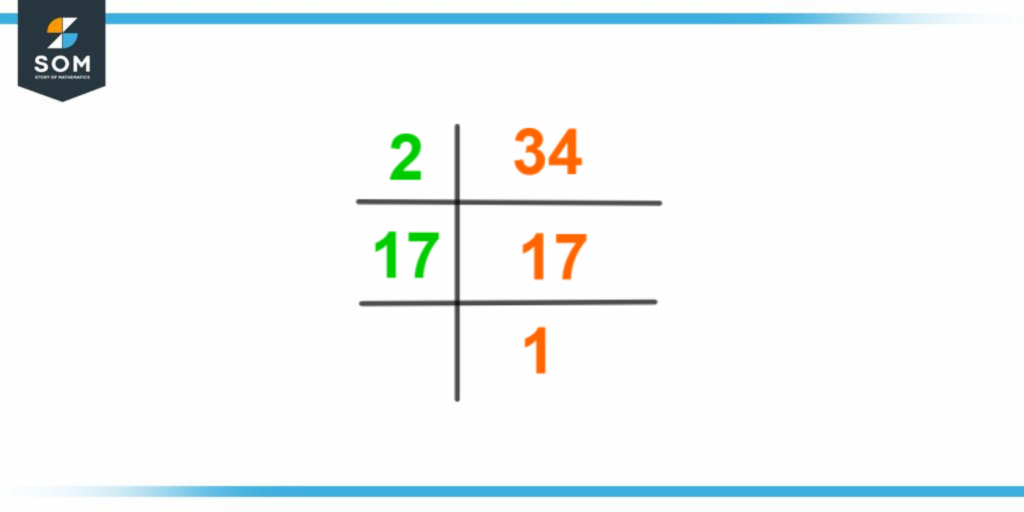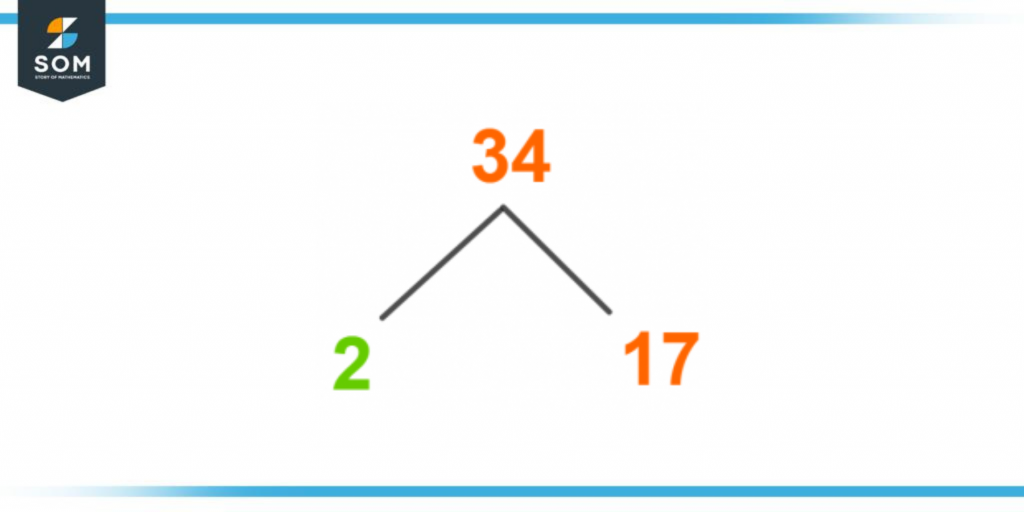JUMP TO TOPIC
Factors of 34: Prime Factorization, Method, Tree, and Examples
All the numbers that fully divide 34 give a whole number as the quotient and leave zero as the remainder. These quotients are called the factors of 34.

Figure 1 – All possible Factors of 34
Factors of 34 can also be described as the pair of two numbers that multiply with each other to give the number 34 as the product.
This article elaborates on the details of the factors of 34 and how to find these factors by using different methods, primarily prime factorization and straight division methods.
Following are the characteristics of the number 34, which must be kept in mind to find out factors of 34.
- 34 is an even number.
- 34 is a composite number.
- 34 is not a perfect square.
- 34 is a Deficient Number.
What Are the Factors of 34?
The factors of 34 are 1, 2, 17, and 34.
Since 34 is an even as well as a composite number, it has four positive factors and four negative factors. All the above-stated factors in their negative form are called negative factors of 34. All the numbers are also divisors of 34 because when the number 34 is subjected to divide by any of the mentioned numbers, it is divided completely and leaves zero or nothing as a remainder.
How To Calculate the Factors of 34?
You can calculate the factor of 34 by using the division method. For this purpose, start dividing 34 by the smallest natural number that divides 34 perfectly without leaving any remainder.
Divide 34 by the smallest natural number, which is 1.
\[ \dfrac{34} {1} = 34, r = 0\]
Since 1 has completely divided 34 without leaving any remainder ( r = 0). So, 1 is a factor of 34.
Now divide 34 by the following consecutive natural number, i.e.,2, the smallest even prime number.
\[ \dfrac{34} {2} = 17, r = 0\]
As the number 34 has been entirely divided by its divisor. So, 2 is also a factor of 34. Now try to divide 34 by the following consecutive natural number, 3.
\[ \dfrac{34} {3} = 11.33, r ≠ 0\]
Because 3 has not divided 34 entirely, and the quotient is not a whole number. Therefore, 3 is not a factor of 34.
To achieve more factors, divide 34 by natural numbers that completely divide 34 and leave zero remainders as shown below:
\[ \dfrac{34} {17} = 2, r = 0\]
\[ \dfrac{34} {34} = 1, r = 0\]
The number 34 has wholly been divided by these numbers and has left no remainder. Therefore, all the numbers 1, 2, 17, and 34 are factors of 34.
Essential Facts About the Factors of 34
- 1 is the smallest factor of 34 and is not a prime factor.
- The number 34 cannot have any factor which is larger than itself. Hence 34 is the largest factor of the number 34.
- 34 has only one composite factor, which is itself.
- The number 34 has 2 prime factors.
- The sum of divisors of 34 is 54.
Factors of 34 by Prime Factorization
The portrayal of the number 34 as a product of all of its prime factors is called prime factorization of the number 34. Prime factorization is one of the effective methods that can be used to find out the factors of 34.
To achieve the purpose, divide 34 by the smallest prime number, which separates 34 perfectly without leaving anything behind as a remainder. The next quotient obtained is again divided by the prime factor, usually the smaller one. The procedure continues until one is received, and further division is impossible.
Following are the steps to calculate factors of 34 by the prime factorization method.
The first step in the procedure is dividing 34 by the smallest possible prime number, 2.
\[ \dfrac{34} {2} = 17 \]
As the number obtained in the quotient is 17, a prime number, it can further be divided by itself only.
\[ \dfrac{17} {17} = 1 \]
The quotient 1 cannot be divided any further.
Therefore, the prime factorization of 34 can be expressed as follows:
34 = 2 x 17
The prime factorization of 34 is also shown in following figure 1.

Figure 2 – Prime factorization of 34
Factor Tree of 34
A factor tree is another approach to determine the factors of 34. A factor tree is a pictorial representation where the prime factorization of the number 34 is established in the form of a tree whose branches represent the divisors of the said number.
The division of a branch can result in the generation of either a prime or composite number. If any of the two sub-divisions resulting from this split produces a composite number, the division continues to go down until it makes prime numbers on both branches. This is where the branching or division stops.
If we write 34 into multiples, it would be:
34 = 2 x 17
It is essential to note that the number 32 has generated prime numbers on both branches in a single divide. Therefore, it cannot be divided into its further branches; the factor tree of 32 appears as following figure 2.

Figure 3 – Factor Tree of 34
Factors of 34 in Pairs
A set of two natural numbers, multiplied to generate the number 34, are called factor 34 in pairs.
In another way, it is stated as the product of the factors of the number 32 in the form of pairs.
1 x 34 = 34
2 x 17 = 34
17 x 2 = 34
34 x 1 = 34
The number 34 has total 4 factors, which can be written in pairs as below:
(1, 34)
(2, 17)
(17, 2)
(34, 1)
As the multiplication of two negatives always produces a positive product. Therefore, when multiplied, the pair factors of 34 in negative form result in a positive 34. Hence, the following are also pair factors of 34.
(-1) x (-34) = 34
(-2) x (-17) = 34
Here are the negative pair factors of number 34.
(-1, -34)
(-2, -17)
Important Tips
- Only integers and whole numbers can be the factors of any number.
- Factors of any number cannot be in decimals or fractions.
- All the positive pair factors of a number are also pair factors of the same number in their negative form.
Factors of 34 Solved Examples
Example 1
Emma has been given pair factors of 34. She has been asked to pick the pair factor which fulfills the following conditions:
- A pair factor with both prime numbers.
- A pair factor with one odd and one even number.
Help her pick the necessary pair factors from the following sets of pair factors.
- (1, 34)
- (2, 17)
Solution
Emma knows that in the two sets of pair factors given above, the first set (1, 34), despite fulfilling the condition of one odd and one even number, has a composite number which is 34. Also, 1 is neither a prime nor composite number. Hence, the pair factors (1, 34) do not fulfill the conditions stated in the question.
As Emma knows that the other set of pair factors (2, 17) fulfills all the conditions in question as:
- Both the factors in the set (2, 17); 2 and 17 are prime numbers.
- In the set (2, 17), the number 2 is an even number, and 17 is an odd number.
Hence, the factor pair consisting of both prime numbers as well as one even and one odd number is:
(2, 17)
Example 2
Anthony decided to write 2 pages daily in his notebook to improve his writing skills. After writing 34 pages, he could not continue the practice. Calculate how many days he continued to write two pages daily.
Solution
The number of total pages written can be found by the product of the number of pages written on daily basis and the number of days he wrote the pages.
Number of pages written daily = 2
The total number of days =?
Total number of pages written = 34
2 × (total days) = 34
Total days = 34 ÷ 2
Total days = 17
Hence, Anthony continued the practice for 17 days in total.
Example 3
Name the methods by which factors of 34 can be found.
Solution
Factors of 34 can be found by following methods:
- Factors of 34 by Division Method.
- Factors of 34 by Multiplication Method.
- Factors of 34 by Prime Factorization Method.
- Factors of 34 by Factor Tree Method.
Example 4
Which of the following statement is not true about factors of 34?
- 34 has four factors in total.
- 34 has only two prime factors, which are 2 and 17.
- 34 can have one positive and one negative factor in the pair.
- Pair Factors of 34 can have one even and one odd number.
Solution
The product of one positive and one negative number is always negative. Hence, 34 can never have one positive and another negative factor in pairs. So the False statement is 34 can have one positive and one negative factor in pairs.
Images/mathematical drawings are created with GeoGebra.
